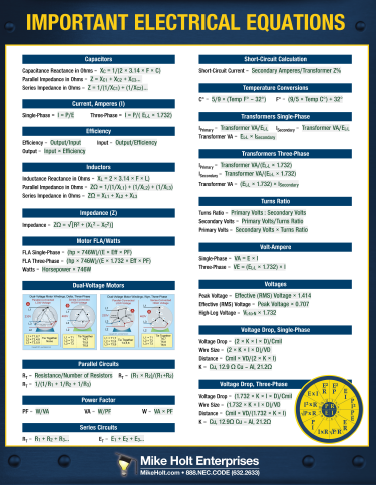- About Us
- Contact Us
- Testimonials
- Continuing Education
- Approved Courses
- Course Login
- Electrical Engineer PDHs
- ICC Approved Courses
- Live CEU Seminars
- NABCEP CEUs
- Electrical Engineering
- Electrical Engineer PDHs
- Engineers Library
- Exam Preparation
- Florida State Exam Prep
- Inspector (Electrical)
- Journeyman Exam Prep
- Masters Exam Prep
- State Licensing Boards
- Free Stuff
- Charts & Calculators
- Code Forum
- Find an Expert
- Find a School
- Graphic of the Day
- Job Board
- Links
- NEC
- Newsletters
- Publications
- Podcasts
- Technical
- Videos
- Instructors & Schools
- Apprenticeship
- Capacitor Login
- ISBNs
- Training Solutions
- Request a Quote
- Products
- Best Values
- Books & DVDs
- Clearance
- Seminars
- CEU Seminars
- Seminar Schedule
Electrical Formulas
Mike Holt's Electrical Equations Chart PDF 1.4 MB
| Subject | Description | Word™ | Excel™ | |
| Arc Blast Calculator | Spreadsheet to calculate Arc Blast in accordance with NFPA 70E | — | Download | — |
| Fault Current | Electrical Plan Review: Calculations Answer Sheet | — | — | Download |
| Fault Current | Electrical Plan Review: Manual Inside | — | — | Download |
| Fault Current | Electrical Plan Review: Cover and Diagram | — | — | Download |
| Fault Current | Calculator: Point-to-Point Method by John Sokolik | — | Download | — |
| FIPS 94 - Electrical Power for Computer Installations | This is excellent publication (1-23-99) | — | — | Download |
|
kVar
Calculator [ Link ] |
Manachos Engineering's Calculator for design and construction of electromechanical projects | — | — | — |
| Capacitor kVAR Calculator | Spreadsheet to determine capacitor kVAR required to improve power factor (PF). | — | Download | — |
| Software [ Link ] | Flashworks - Electrical Service Load Calculations including: Panel Sizing & Balancing, Conductor & Conduit Sizing, Short Circuit Calculation, and Voltage Drop Calculations for both Residential, Commercial and Industrial buildings | — | — | — |
| Residential Load Calculations | Dwelling Unit | — | — | — |
| Touch Potential 2-Wire Circuit | Open Neutral 2-Wire Circuits | — | Download | — |
| Touch Potential 3-Wire Circuit | Open Neutral 3-Wire Circuits | — | Download | — |
| Wiring and Raceway Chart | Just view and print! | — | — | Download |
Area of Circle = \(\pi r^2\)
Breakeven Dollars = Overhead Cost $/Gross Profit %
Busbar Ampacity AL = 700A Sq. in. and CU = 1000A Sq. in.
Centimeters = Inches x 2.54
Inch = 0.0254 Meters
Inch = 2.54 Centimeters
Inch = 25.4 Millimeters
Kilometer = 0.6213 Miles
Length of Coiled Wire = Diameter of Coil (average) x Number of Coils x \(\pi\)
Lightning Distance in Miles = Seconds between flash and thunder/4.68
Meter = 39.37 Inches
Mile = 5280 ft, 1760 yards, 1609 meters, 1.609 km
Millimeter = 0.03937 Inch
Selling Price = Estimated Cost $/(1 - Gross Profit %)
Speed of Sound (Sea Level) = 1128 fps or 769 mph
Temp C = (Temp F - 32)/1.8
Temp F = (Temp C x 1.8) + 32
Yard = 0.9144 Meters
Electrical Formulas Based on 60 Hz
Capacitive Reactance (Xc) in Ohms = 1/(2\(\pi\) f C)
Effective (RMS) AC Amperes = Peak Amperes x 0.707
Effective (RMS) AC Volts = Peak Volts x 0.707
Efficiency (percent) = Output/Input x 100
Efficiency = Output/Input
Horsepower = Output Watts/746
Inductive Reactance (XL in Ohms = 2\(\pi\) f L
Input = Output/Efficiency
Neutral Current (Wye) =\(\sqrt{A^2+B^2+C^2-(AB+BC+AC)}\)
Output = Input x Efficiency
Peak AC Volts = Effective (RMS) AC Volts x \(\sqrt 2\)
Peak Amperes = Effective (RMS) Amperes x \(\sqrt 2\)
Power Factor (PF) = Watts/VA
VA (apparent power) = Volts x Ampere or Watts/Power Factor
VA 1-Phase = Volts x Amperes
VA 3-Phase = Volts x Amperes x \(\sqrt 3\)
Watts (real power) Single-Phase = Volts x Amperes x Power Factor
Watts (real power) Three-Phase = Volts x Amperes x Power Factor x \(\sqrt 3\)
Parallel Circuits
Note 1: Total resistance is always less than the smallest resistor
Note 1: RT = 1/(1/R1 + 1/R2 + 1/R3 +...)
Note 2: Total current is equal to the sum of the currents of all parallel
resistors
Note 3: Total power is equal to the sum of power of all parallel resistors
Note 4: Voltage is the same across each of the parallel resistors
Series Circuits
Note 1: Total resistance is equal to the sum of all the resistors
Note 2: Current in the circuit remains the same through all the resistors
Note 3: Voltage source is equal to the sum of voltage drops of all resistors
Note 4: Power of the circuit is equal to the sum of the power of all resistors
Transformer Amperes
Secondary Amperes 1-Phase = VA/Volts
Secondary Amperes 3-Phase = VA/(Volts x \(\sqrt 3\))
Secondary Available Fault 1-Phase = VA/(Volts x %impedance)
Secondary Available Fault 3-Phase = VA/(Volts x \(\sqrt 3\) x %Impedance)
Delta 4-Wire: Line Amperes = Phase (one winding) Amperes x \(\sqrt 3\)
Delta 4-Wire: Line Volts = Phase (one Winding) Volts
Delta 4-Wire: High-Leg Voltage (L-to-G) = Phase (one winding) Volts x 0.5 x \(\sqrt
3\)
Wye: Line Volts = Phase (one winding) Volts x \(\sqrt 3\)
Wye: Line Amperes = Phase (one winding) Amperes
Voltage Drop
VD (1-Phase) = 2KID/CM
VD (3-Phase) = \(\sqrt 3\) KID/CM
CM (1-Phase) = 2KID/VD
CM (3-Phase) = \(\sqrt 3\) KID/VD
Code Rules
Breaker/Fuse Ratings – 240.6(A)
Conductor Ampacity – 310.15 and Table 310.16
Equipment Grounding Conductor – 250.122
Grounding Electrode Conductor – 250.66
Motor Conductor Size – 430.22 (Single) 430.24 (Multiple)
Motor Short-Circuit Protection – 430.52
Transformer Overcurrent Protection – 450.3
Constants
\(\pi\)(Pi) = (3.142 approximately)
\(\sqrt 2\) = 1.414 (approximately)
\(\sqrt 3\) = 1.732 (approximately)
f = Frequency
r = radius
d = diameter
C = Capacitance (farads)
L = Inductance (henrys)
CM = Circular Mils (Chapter 9, Table 8)
VD = Volts Drop
K75oC = (12.9 ohms CU) (21.2 ohms AL)
I = Amperes of load
D = Distance in ft one way






